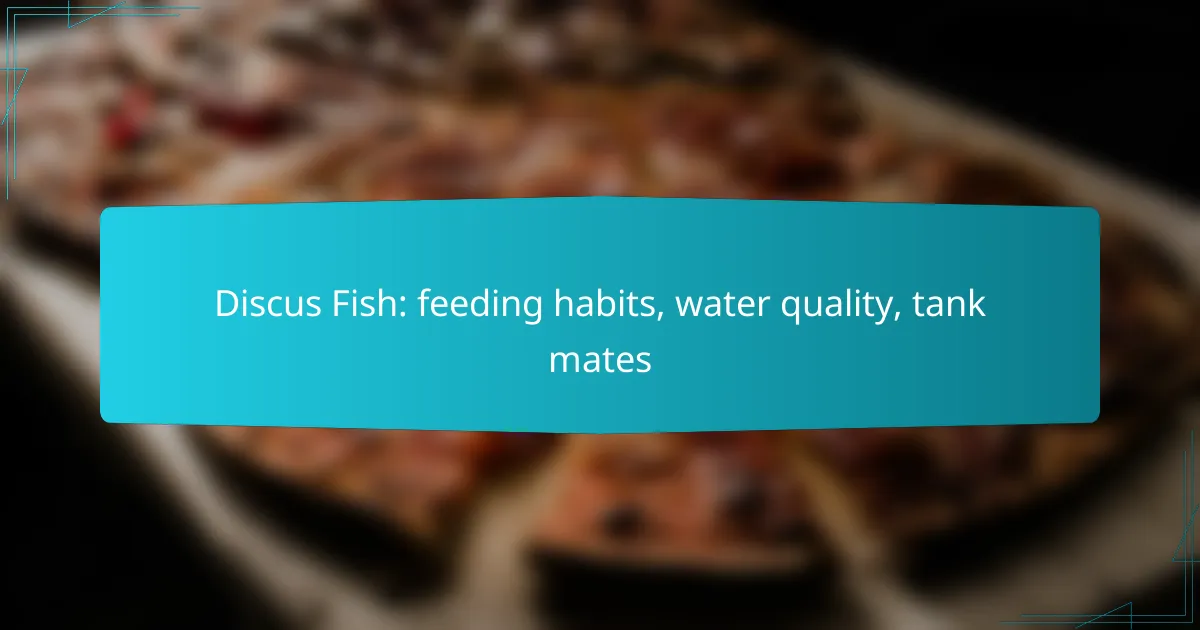Discus fish are known for their striking appearance and require a carefully balanced diet that includes high-quality pellets, frozen or live foods, and some vegetable matter to maintain their health and vibrant colors. To thrive, they need optimal water quality, with specific attention to temperature, pH levels, and regular maintenance. Additionally, selecting compatible tank mates that share similar water conditions and temperaments is essential for creating a peaceful aquarium environment.

What do Discus Fish eat?
Discus fish primarily consume a varied diet that includes high-quality pellets, frozen or live foods, and vegetable matter. Providing a balanced diet is crucial for their health and vibrant coloration.
High-quality pellets
High-quality pellets are a staple in the diet of discus fish. These pellets should be specifically formulated for cichlids, as they contain essential nutrients and vitamins necessary for growth and health.
When selecting pellets, look for those that list whole fish or shrimp as the first ingredient. Avoid fillers like corn or wheat, as they do not provide the necessary nutrition for discus fish.
Frozen or live foods
Frozen or live foods, such as bloodworms, brine shrimp, and daphnia, are excellent additions to a discus fish’s diet. These foods are high in protein and can stimulate natural hunting behaviors.
Incorporating a variety of these foods can enhance the fish’s color and overall vitality. However, ensure that any live food is sourced from reputable suppliers to prevent introducing diseases into the tank.
Vegetable matter
Discus fish also benefit from vegetable matter, which can include blanched spinach, zucchini, or spirulina flakes. These foods provide essential fiber and help with digestion.
Offering vegetable matter a few times a week can promote a balanced diet and prevent health issues related to a protein-heavy diet.
Feeding frequency
Discus fish should be fed 2-3 times a day, with small portions that can be consumed within a few minutes. This frequent feeding mimics their natural feeding habits and helps maintain their energy levels.
Overfeeding can lead to water quality issues and health problems, so it’s crucial to monitor their intake and adjust accordingly.
Diet variations
Diet variations can depend on the age and size of the discus fish. Young discus require more protein-rich foods for growth, while adults can thrive on a more balanced diet of pellets, frozen foods, and vegetables.
It’s important to observe how your fish respond to different foods and adjust their diet to ensure they remain healthy and vibrant. Regularly rotating food types can also prevent dietary boredom and encourage active feeding behavior.

How to maintain water quality for Discus Fish?
Maintaining water quality for Discus Fish is crucial for their health and well-being. Key factors include temperature, pH levels, ammonia and nitrite levels, and regular water changes.
Optimal temperature range
The optimal temperature range for Discus Fish is typically between 26°C and 30°C (79°F to 86°F). Keeping the water within this range helps ensure their metabolic processes function properly.
Use a reliable aquarium heater to maintain consistent temperatures, as fluctuations can stress the fish. Regularly monitor the temperature with a thermometer to avoid sudden changes.
pH level requirements
Discus Fish thrive in slightly acidic to neutral water, with a pH level between 6.0 and 7.5. Maintaining this pH range is essential for their health and breeding behavior.
Test the water regularly using a pH test kit. If adjustments are needed, consider using pH buffers or natural methods like driftwood, which can help lower pH levels gradually.
Ammonia and nitrite levels
Ammonia and nitrite levels should be kept at zero, as even low concentrations can be harmful to Discus Fish. Regular testing is crucial to ensure these toxic substances do not accumulate.
To manage ammonia and nitrite levels, establish a robust biological filtration system and perform regular water changes. Avoid overfeeding, as uneaten food can contribute to these harmful compounds.
Water change frequency
Regular water changes are vital for maintaining water quality for Discus Fish. A frequency of 25% to 50% water changes weekly is recommended to keep the environment clean and stable.
When performing water changes, use a dechlorinator to treat tap water and ensure the new water matches the tank’s temperature and pH. This practice helps remove waste and replenish essential minerals.

What are the best tank mates for Discus Fish?
Discus fish thrive best with compatible tank mates that share similar water quality and behavioral traits. Ideal companions include peaceful species that can coexist in the same temperature and pH range, ensuring a harmonious aquarium environment.
Compatible species
Discus fish are best paired with other peaceful freshwater species. Suitable tank mates include cardinal tetras, rummy-nose tetras, and certain types of corydoras catfish. These fish not only enjoy similar water conditions but also tend to have non-aggressive temperaments.
Additionally, larger peaceful fish like angelfish can be compatible, provided there is enough space. Always ensure that the size and temperament of potential tank mates align with the needs of discus fish.
Incompatible species
Some species should be avoided as tank mates for discus fish due to their aggressive nature or differing water requirements. Cichlids, particularly those known for territorial behavior, can pose a threat to discus. Species such as barbs and certain livebearers may also nip at fins, causing stress.
Moreover, fish that prefer significantly different water parameters, like very hard or alkaline water, should not be housed with discus. This includes many species from African rift lakes.
Tank size considerations
Discus fish require ample swimming space, so a larger tank is essential for maintaining harmony with tank mates. A minimum of 200 liters (approximately 53 gallons) is recommended for a small group of discus and their companions. This size allows for adequate territory and reduces stress among fish.
When adding tank mates, consider the total bioload and ensure that the tank is not overcrowded. Overcrowding can lead to poor water quality and increased aggression among fish.
Behavioral compatibility
Behavioral compatibility is crucial when selecting tank mates for discus fish. They are generally shy and prefer calm environments, so tank mates should exhibit similar temperaments. Avoid species that are overly active or aggressive, as this can lead to stress for the discus.
Monitor interactions closely, especially during feeding times. Discus fish can be outcompeted for food, so ensure that all species can access nourishment without conflict. Regular observation will help identify any potential issues early on.

What are the ideal tank conditions for Discus Fish?
The ideal tank conditions for Discus Fish include a spacious aquarium with excellent water quality and appropriate tank mates. Maintaining stable water parameters and providing a suitable environment is crucial for their health and well-being.
Tank size recommendations
Discus Fish thrive in larger tanks, ideally starting from 200 liters (approximately 53 gallons) for a small group. A larger tank allows for better water quality management and reduces stress among the fish. Aim for at least 50 liters (around 13 gallons) per fish if keeping a small school.
Filtration systems
Effective filtration is essential for maintaining the water quality that Discus Fish require. A high-capacity filter, such as a canister filter, is recommended to handle the bioload and keep the water clean. Look for filters with a flow rate that can turn over the tank volume several times per hour.
Decor and hiding spots
Providing decor and hiding spots is important for the comfort of Discus Fish. Use plants, driftwood, and rocks to create a natural environment that offers shelter. Ensure that the decor does not obstruct swimming space, as Discus prefer open areas for swimming and socializing.

How to set up a Discus Fish tank?
Setting up a Discus Fish tank requires careful attention to water quality, tank mates, and overall environment. A well-prepared tank ensures the health and happiness of these sensitive fish.
Substrate options
Choosing the right substrate for a Discus Fish tank is crucial for both aesthetics and functionality. Fine gravel or sand is often recommended, as it allows for easy cleaning and mimics their natural habitat. Avoid sharp substrates that could injure the fish.
Additionally, consider the thickness of the substrate layer; a depth of around 2-3 inches is generally sufficient for planting and maintaining beneficial bacteria. This helps in keeping the water quality stable.
Water conditioning
Discus Fish thrive in soft, slightly acidic water, typically with a pH between 6.0 and 7.5. Regular testing and conditioning of the water are essential to maintain these parameters. Use reverse osmosis (RO) water or deionized water to achieve the desired softness.
Moreover, ensure that the water temperature is consistently kept between 26-30°C (79-86°F). Frequent water changes of about 25% weekly will help keep the tank clean and the fish healthy.
Lighting requirements
Discus Fish prefer dim lighting that mimics their natural habitat. Using subdued lighting can help reduce stress and encourage natural behaviors. LED lights with adjustable intensity are a good option, allowing you to customize the brightness.
Consider a light cycle of around 10-12 hours per day, which supports plant growth and maintains a natural day-night rhythm. Avoid direct sunlight, as it can lead to algae growth and temperature fluctuations.










